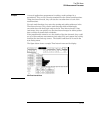
Time Interval mode
Time Interval mode shows distribution of execution time of a single event.
The event is defined by specifying Start and End conditions as patterns
across all labels defined in the Format menu.
Data sampling and sorting
When you press Run, the analyzer samples
the target system using the definitions entered in the Format menu.
During acquisition, the state analyzer searches the data for the start and
end conditions, and uses the analyzer’s time tag feature to time the
event. The time durations for each Start/End pair are then sorted into
user-definable time interval ranges on the display. The acquisition is
repeated until Stop is pressed or until a display variable is changed.
After the data is sampled, timed, and sorted, the histogram for each time
interval range is updated.
If two time intervals are adjacent and have a common boundary (the upper
limit of one equals the lower limit of the next), and a sampled time interval
falls on the common boundary, the sample will be sorted into the higher time
interval.
Start/End conditions
Start and end conditions for Time Interval are
specified on all labels defined in the Format menu as a combination of
values in the current base and don’t cares.
If a start or end condition is not found during an acquisition, the histogram
will not change. The analyzer will only update when a start and stop event
are both found.
Start and end conditions need not be adjacent in the data stream. For
example, when the state analyzer sees the specified start condition, it starts
the timer. If the start condition occurs again before the end condition occurs,
the timer will not be reset.
For measurement purposes, the analyzer measures the time between the first
occurrence of the start condition and the first occurrence of the stop
condition.
The SPA Menu
SPA Measurement Processes
11-15


















